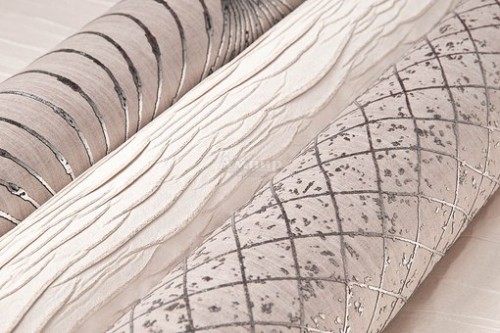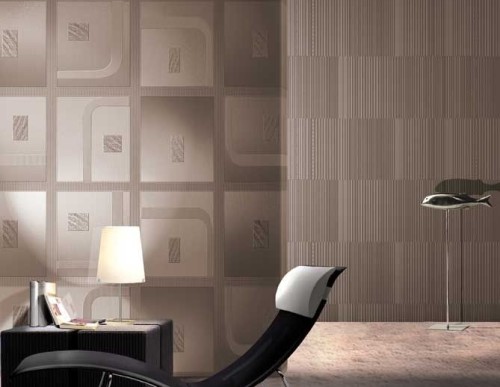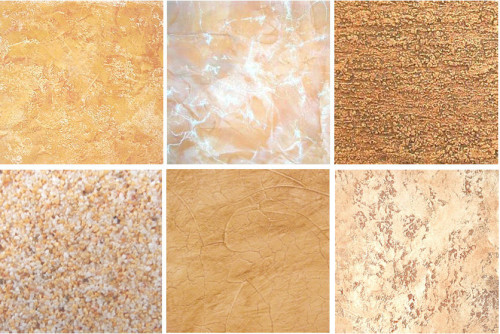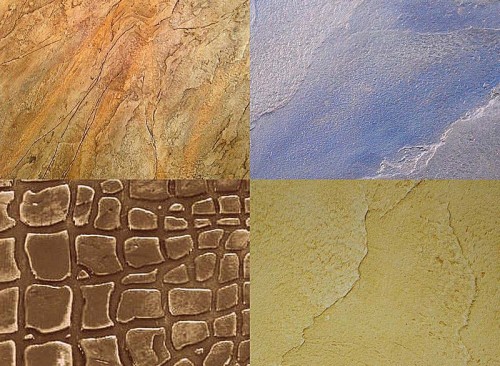If you want to cover the walls of your home with a satin or finish the facade with marble, there is nothing easier. A textured finish will help you with this - using a variety of finishing materials, you can achieve various decoration effects. This technique will allow hiding the irregularities of the walls, create a special texture and relief of the surface, giving design to the uniqueness and originality.
Content
Types of textured coatings
Professional designers widely use textured wall decoration. With its help, it is easy to simulate in the wall covering the texture of wood, stone, various types of weaving, trellises, tapestries, create various fantasy compositions on the walls. A similar effect can also be achieved independently by designing textured walls with your own hands. A rich selection of finishing materials allows you to creatively and with small costs transform the surface of the walls in a wide variety of styles.
Textured wallpaper
Coatings from embossed (textured) wallpaper allow various effects of decorating rooms. With their help, you can visually adjust the proportions of the interior - “spread” the walls and “raise” low ceilings. Thanks to the use of modern technologies, the texture of such wallpapers successfully imitates various materials, aligns the irregularities of the walls and works miracles with the volume of the room.
The following options for textured wallpaper are presented on sale:
- paper - initially such wallpaper imitated the texture of tapestries and trellises due to special printing methods. Currently, textured wallpaper for walls has acquired a real relief. In them, a two -layer (duplex) wall coating consists of a decorative paper layer fixed on a paper or non -woven basis. At the same time, a decorative relief on them is created by embossing, artistic printing, or using other technologies. Modern textured wallpapers made of quality material are characterized by staining staining, as well as wear resistance, and can last for 5-10 years-until the next cosmetic repair. The textured wall decoration with paper wallpaper is suitable, including for a children's room or bedroom, since these finishing materials are environmentally friendly and excellent breathability;
- vinyl - such wallpapers consist of a layer of polyvinyl chloride (PVC), placed on the basis of technical paper or non -wovers. To do this, the foamed polymer mass using special technologies is applied to the base layer, forming a textured decor. The technology for the production of silk -graphic wallpapers by sophisticated embossing allows you to imitate ancient wallpaper textiles (the so -called rod). Vinyl wallpaper is suitable for decoration of walls of various rooms, including with a high -humidity regime - kitchen, bathroom, as they do not absorb moisture, they are perfectly washed with various means of household chemicals, and are resistant to significant temperature changes. The vinyl wallpaper with micropores that recently appeared on the market have increased breathability and allow the walls to “breathe”, while the water that falls on their surface quickly evaporates, without absorbing the coating. Thus, moisture does not accumulate on the walls under the wallpaper, therefore, a fungus or mold will not appear under them;

- non -woven - such wallpapers are made of polyester and acrylic with the addition of natural viscose fiber by hot pressing without the use of chemicals. Such wallpapers are environmentally friendly, elastic and little prone to deformations. In addition, they are distinguished by excellent soundproofing properties and provide ample opportunities for decoration. Currently, non -woven wallpaper with a relief texture in ethnic style, as well as corrugated, are very popular;
- natural wall coatings made of natural materials (which can be Sisal, Traffic, Bamboo, Jut, reed, trees bark). Such textured wallpaper differs in a fairly high cost. They are suitable for various rooms, including with a regime of high humidity, although it is still not recommended to place them in the immediate vicinity of the bath, washbasin and shower booth;
- wallpaper for painting - vinyl, as well as paper with a layer of wooden chips. Such a wall covering of white, cream, greenish color differs from painted wallpaper with a pronounced relief, which will acquire its final appearance after applying the paint of the selected shade;
- glass wallpaper - are a woven or wicker coating on a paper basis. Such structural wallpaper is painted with acrylic or silicone paints. The glass wallpaper is characterized by high wear resistance to abrasion and the effects of detergents, so they can be used to finish frequently visited rooms - corridors, halls, hallways.
Textured paint
Textured paints are widely used for interior decoration in various styles, as well as for external work. This finishing material in its structure resembles a decorative plaster and is a viscous mass of white with various interspersed. Acrylic, silicate or silicone dispersions can act as the basis of textured paint. In addition, mineral fillers are added to its composition - a crumb of granite or marble, gas -slander, quartz sand, as well as artificial materials - polymer fibers that form a certain texture and various relief on the surface of the coating. Initially, the textured paint for the walls is produced in white, while giving it any shades she like is easy, adding a special dye (color-painting) of a suitable shade. On sale, textured paints for the base of the building, facade, as well as for internal work are presented.
The textured wall color will help to align small irregularities and create a homogeneous coating on them. Thus, before applying the wall paint, it is not necessary to align to the state of perfect smoothness, it is enough to clean their surface from garbage and exfoliating plaster, and then primed for the subsequent application of structural paint. The primer will contribute to a better clutch of textured coating with walls.
The following advantages of textured paint can be noted:
- high breathability - even the coating applied with a thick layer allows the walls to “breathe” without creating a barrier for moisture and steam;
- structural paints do not contain solvents, such a decoration is safe for health;
- high frost resistance that allows the use of this finishing material for external work;
- thanks to the acrylic binder component, structural paints are resistant to various atmospheric influences. Such a textured wall coating is characterized by high wear resistance and durability.
It is worth noting that for textured wall decoration you need a significant consumption of structural paint-about 500-1500 g/m/m 2. This is due to the thickness of the textured coating, which can reach 1 cm (while facade paints are usually applied with a layer of 0.2-0.3 mm). The textured paint is applied to the walls with a special roller, in addition, it is convenient to use to apply textured coating with a powerful vacuum cleaner or a specialized pumping station that can be purchased or rented.
Textured plaster
Currently, the decoration of walls with textured plaster, which allows you to create various decorative coatings on the walls, is gaining more and more popularity. Due to the presence in its composition of special binders and forming additives, you can create a wall covering with various patterns and relief.
Depending on the composition, the following varieties of this finishing material are distinguished:
- acrylic plaster is made on the basis of acrylic resin. This material is sold in the form of a finished mixture, which is conveniently applied to various building surfaces. Such a coating is elastic and if necessary will hide small cracks on the wall formed as a result of shrinkage. The disadvantages of acrylic plaster include the absence of air permeability, as well as the ability to absorb and accumulate dust, due to which over time the facade coating may fade;
- in silicone plaster, silicone resins act as a binder component. This finishing material is characterized by high plasticity, convenience in applying and durability (service life - up to 25 years), suitable for mineral and other surfaces, air permissive and does not absorb salts, is used for external and internal work;
- mineral plaster is sold in the form of a dry mixture based on cement and sand, which must be kneaded immediately before use. Mineral baby in the plaster gives such a coating the desired relief. Such plaster is convenient in work, even a novice master can cope with its application. The disadvantages of this type of plaster should include a short service life (up to 10 years), as well as the absence of elasticity and the possibility of cracks on the facade;
- silicate plaster can be purchased in the form of a finished mixture. This finishing material is quite plastic and convenient in application. Silicate textured coating is elastic and resistant to cracks, it is durable and breathable, has antistatic properties and does not attract dust.
The textured plaster for the walls of varieties “bark beetle” and “marble” is particularly popular in the decoration-the first got its name because of the characteristic coating, reminiscent of wood with a bug-brown wood, the second-due to the presence of marble crumbs and dust.
For internal work, it is recommended to choose a textured putty for walls of fine -grained composition or plaster with granules of various granularity (without particularly large ones) - such a relief finish will look quite organically on the walls of the room. You can get a homogeneous sewage coating of the outer walls using compositions with calibrated marble and granite filler. If there are large inclusions in the plaster, you will need to use a steel ironer instead of a roller.
The advantages of using textured walls for walls include the ease of application and plasticity - with its help it is easy to arrange textured walls with your own hands without the availability of experience of such work, as well as wide possibilities for decorating walls. Using this finishing material, you can create various types of coating with imitation of a marble or sand surface, rocky relief, fantasy patterns. At the same time, the color scheme of wall decoration is not limited-you can purchase a finished painted solution or select the colors yourself, adding the color column of the desired shades. In addition, the coating from textured plaster is resistant to mechanical and atmospheric influences, strength and durability.
Do -it -yourself textured plaster technology
Having selected the right material, you can proceed to the design of textured walls. Since the freshly launched layer of plaster freezes on the wall, you will need to work at a fast pace, preferably together. It will be necessary to apply a dense layer of plaster on the wall and smooth it with a spatula or ironer, and then form the relief of the finish using suitable tools. After 10-15 minutes, the textured coating will completely freeze, and it will not be possible to make any adjustments.
Preparatory work
Before applying textured plaster, it will be necessary to pre -prepare the surface of the walls. To do this, the old wallpaper is removed from it, the exfoliated whitewashing and paint, so to get a dense and homogeneous surface. Painful leveling of walls will not be needed - textured plaster will subsequently hide small irregularities and small surface defects. Next, it is necessary to apply a deep penetration on a purified dry surface. It is necessary to process the walls in this way the day before applying textured plaster. The primer will fill the surface microcracks and help to avoid the development of mold and fungus under plaster.
For applying the textured coating walls, ironing, plastering cells, spatulas of different sizes, special rollers, sponges, stamps and other devices for the formation of surface relief can be needed. Depending on your desire, as a result of such wall processing, various results can be achieved.
Ways to apply textured coating
There are various methods of decorating textured walls with your own hands:
- a roller with a pattern applied - this method is easy to implement and allows you to quickly get a spectacular textured coating;
- using a special stamp to give the relief - you will need to apply the base layer of plaster with a kelma, and then leave prints with a stamp on the surface in the right places;
- the textured wall painting (the so -called sprayer) will help to achieve various original decoration results. To obtain the effect of the “torn surface”, you will need to apply the plaster with the help of a cell, and then process this layer with a texture roller. In addition, you can apply the initial layer of the material with a roller, and then treat it with light briefing movements of the spatula.
Giving textured plaster the original relief is also easy using a special comb or a toothed cell, sponge, cellophane bag. Having experimented a little on a small area of \u200b\u200bthe area, you can then implement on the walls your favorite decoration effects. After completely drying out the coating, you can proceed to painting the surface.
You can create the effect of textured walls “under a fur coat” using a conventional cement-license or cement-sand plaster by spraying. To do this, it is convenient to use special devices (compressors). For lack of those, a brush or a broom with a layer of material, as well as a stick for tapping on them near the processed surface and a metal mesh through which the solution is sprayed on the walls, is used as tools.































